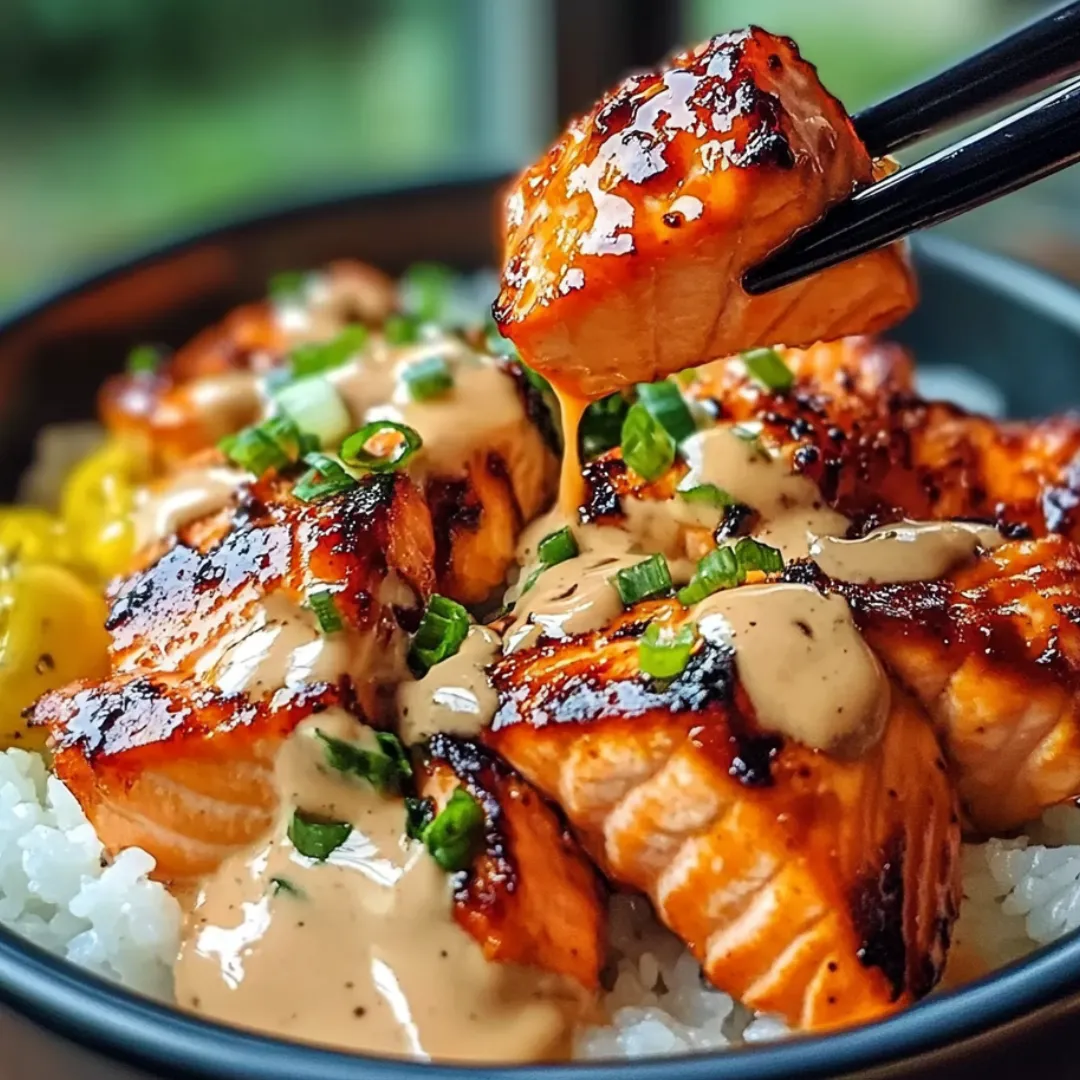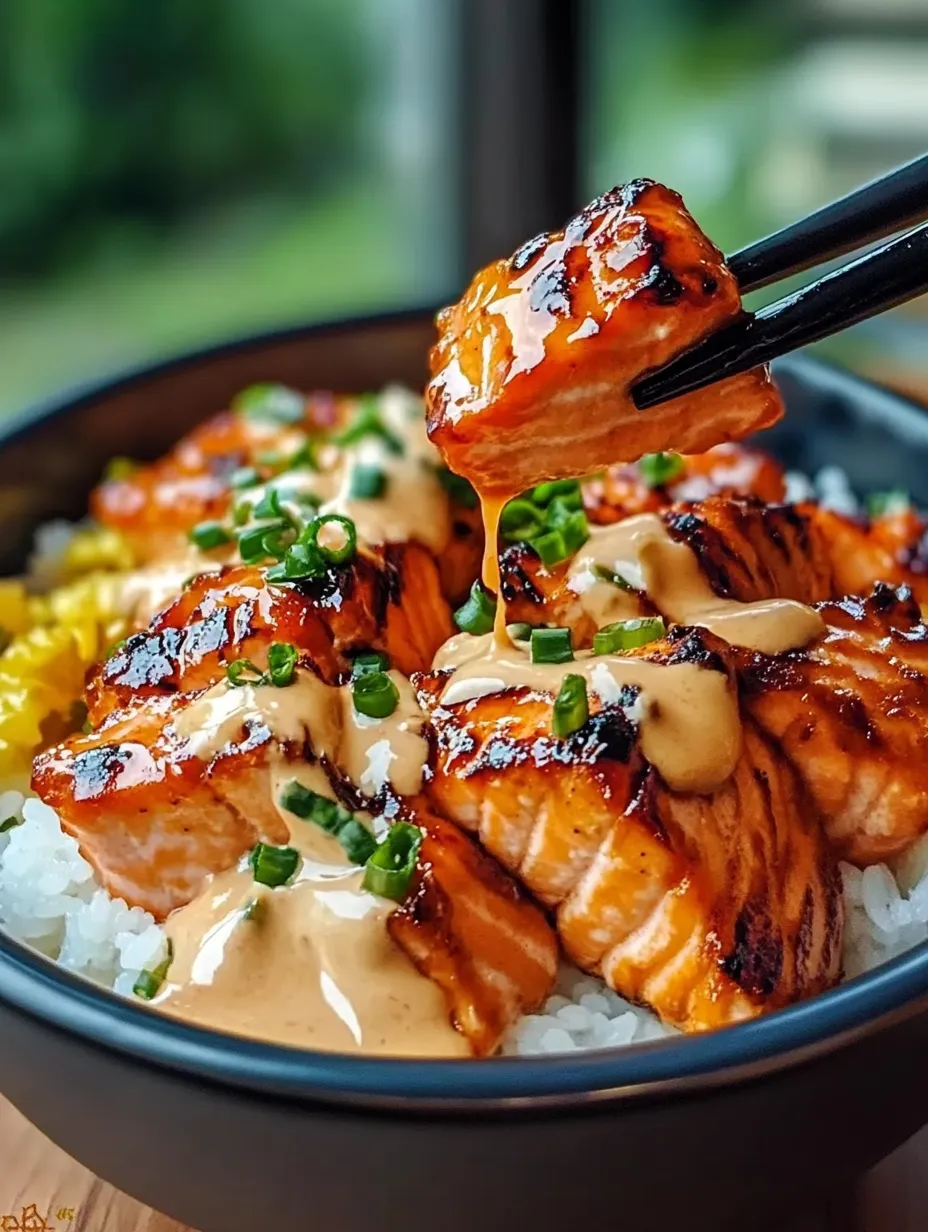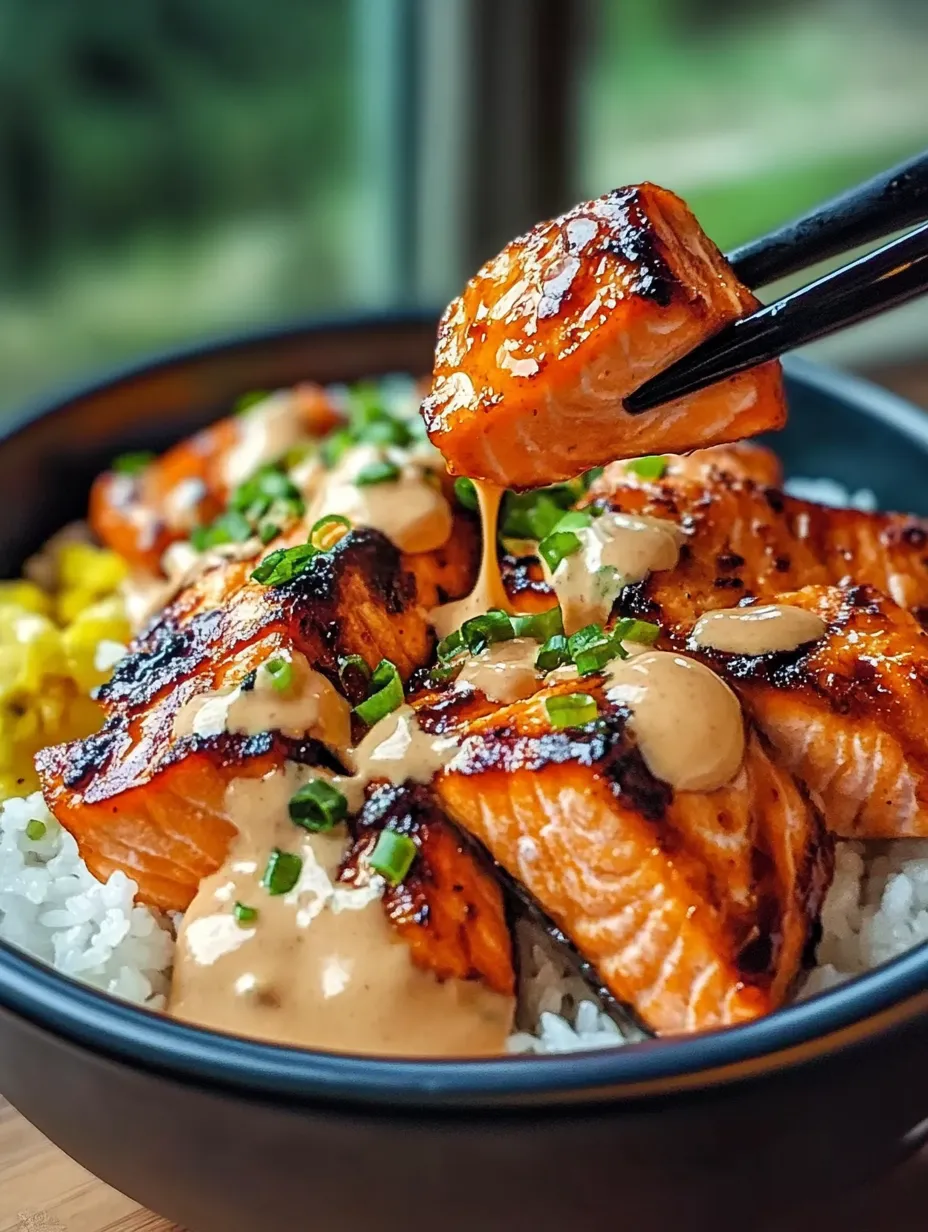 Pin it
Pin it
These Sriracha Honey Salmon Bowls deliver an irresistible combination of sweet, spicy, and savory flavors in every bite. Tender cubes of salmon are glazed with a caramelized sriracha-honey sauce that creates the perfect balance of heat and sweetness, then served over fluffy rice alongside roasted cauliflower for a complete, nourishing meal. The vibrant colors and bold flavors make this dish visually stunning and incredibly satisfying, while the simple cooking process makes it accessible even on busy weeknights. Whether you're meal prepping for the week ahead or serving a quick dinner that still feels special, these bowls provide restaurant-quality taste with minimal effort and basic ingredients.
I first created this recipe during a particularly hectic week when I needed something quick but was tired of my usual go-to meals. The combination of honey and sriracha had worked so well on chicken that I wondered how it might transform salmon, which tends to take on glazes beautifully. That first attempt was a revelation—the sauce caramelized around the salmon edges, creating these irresistible crispy bits while keeping the center perfectly tender. My husband, who typically approaches spicy foods with caution, finished his portion and immediately asked if there was more. What surprised me most was how versatile this preparation proved to be; the salmon was equally delicious hot from the pan for dinner and chilled the next day for lunch. It's since become our Monday night tradition—starting the week with something that feels special but doesn't require excessive time in the kitchen when we're already adjusting to the post-weekend reality.
Essential Ingredients
- Salmon fillets: The star protein that absorbs the flavorful marinade. Choose fresh, wild-caught salmon when possible for the best flavor and nutritional profile. Look for fillets with bright color, firm texture, and no fishy smell.
- Sriracha sauce: Provides the signature heat that balances the sweetness. This Thai-inspired chili sauce contains garlic and vinegar notes that add complexity beyond simple heat. Adjust the amount based on your spice tolerance.
- Honey: Creates the sticky-sweet element that caramelizes beautifully during cooking. Raw, unfiltered honey offers the most complex flavor, but any variety works well in this recipe.
- Soy sauce: Adds essential umami depth and saltiness to balance the sweet-spicy components. Low-sodium versions work perfectly if you're watching salt intake.
- Garlic: Provides aromatic depth that enhances both the sriracha and honey flavors. Fresh minced garlic is preferred over powder for its vibrant flavor.
- Lime juice: The acidity brightens the entire dish and cuts through the richness of the salmon. Fresh lime juice has much more vibrant flavor than bottled versions.
- Sesame oil: Contributes a nutty, toasted flavor that completes the Asian-inspired profile. A little goes a long way—just a teaspoon transforms the entire marinade.
- Cooked rice: Forms the foundation of the bowl, soaking up the delicious sauce. Jasmine rice offers fragrant, fluffy results that complement the bold salmon flavors.
- Roasted cauliflower: Provides textural contrast and additional nutritional value. The slight caramelization from roasting enhances the sweetness in the dish.
- Fresh herbs: Green onions and cilantro add brightness, color, and fresh flavor that balances the rich salmon and sauce.
 Pin it
Pin it
Step-By-Step Preparation
- Create the perfect marinade:
- In a small bowl, whisk together 3 tablespoons sriracha sauce, 3 tablespoons honey, 2 tablespoons soy sauce, 2 cloves minced garlic, 1 tablespoon fresh lime juice, and 1 teaspoon sesame oil until completely combined. The mixture should have a slightly thick consistency that will coat the back of a spoon. This balanced combination creates the foundation of flavor that will permeate the salmon and create a gorgeous glaze. Divide the marinade in half, reserving one portion for cooking.
- Prepare the salmon properly:
- Cut 1 pound of salmon into approximately 1-inch cubes, removing any skin and pin bones as you go. Place the salmon pieces in a shallow dish or resealable bag and pour half of the prepared marinade over them, gently tossing to ensure each piece is evenly coated. Allow the salmon to marinate in the refrigerator for 15-30 minutes. This short marinating time is intentional—the acid in the lime juice and sriracha can start to 'cook' the salmon if left too long, affecting its final texture.
- Roast the cauliflower for textural contrast:
- While the salmon marinates, preheat your oven to 425°F (220°C). Toss 4 cups of cauliflower florets with 1 tablespoon olive oil, ½ teaspoon salt, and ¼ teaspoon black pepper on a rimmed baking sheet. Spread the florets in a single layer, ensuring they aren't overcrowded, which would cause them to steam rather than roast. Bake for 20-25 minutes, tossing halfway through, until the edges are golden brown and slightly crispy. The high heat creates caramelization that enhances the natural sweetness of the cauliflower.
- Cook the rice to fluffy perfection:
- While the cauliflower roasts, prepare 1 cup of jasmine rice according to package instructions. Generally, this involves rinsing the rice until the water runs clear, then combining with 1½ cups water in a medium saucepan. Bring to a boil, reduce heat to low, cover, and simmer for 15 minutes. Remove from heat and let stand, covered, for 5 minutes before fluffing with a fork. This timing aligns perfectly with the rest of the dish components.
- Sear the salmon with intention:
- Heat a large non-stick skillet over medium-high heat and add 1 tablespoon of neutral oil like grapeseed or canola. When the oil is shimmering but not smoking, carefully add the marinated salmon pieces, working in batches if necessary to avoid overcrowding. Sear for approximately 2 minutes on the first side until a caramelized crust forms, then gently turn each piece and cook for 1-2 minutes more until just cooked through. The salmon should be opaque but still moist in the center.
- Create the glossy glaze:
- Once the salmon is cooked, reduce the heat to medium-low and pour in the reserved marinade. Allow it to bubble gently for 1-2 minutes, stirring carefully to coat the salmon pieces. The sauce will thicken slightly as it reduces, creating a glossy glaze that clings to the salmon. This quick reduction concentrates the flavors while ensuring food safety since the marinade hasn't touched raw fish.
- Assemble with an artistic eye:
- Divide the cooked rice among four serving bowls, arranging it as a base. Add a generous portion of roasted cauliflower to each bowl, then top with the glazed salmon pieces. Drizzle any remaining glaze from the pan over the bowls. Garnish with thinly sliced green onions, fresh cilantro leaves, and a sprinkle of sesame seeds. The contrast of colors—white rice, golden cauliflower, glazed salmon, and bright herbs—creates a visually appealing presentation.
- Serve immediately for optimal experience:
- These bowls are best enjoyed while the salmon is still warm and the glaze is at its most flavorful. Provide extra lime wedges on the side for those who enjoy an additional burst of acidity. For those who crave more heat, a small dish of additional sriracha can be offered for personal customization.
The Art of Salmon Selection
Choosing the right salmon significantly impacts the success of this dish. Wild-caught salmon generally offers superior flavor and nutritional benefits compared to farmed varieties, though high-quality farmed salmon can also work well. Sockeye salmon, with its deep red color and firm texture, holds up beautifully to the bold marinade and maintains its shape when cut into cubes. Its higher fat content helps keep the fish moist during the high-heat cooking process required for caramelization. King (Chinook) salmon, the richest and most luxurious variety, creates an exceptionally buttery version of this dish. Its natural omega-3 oils combine with the glaze for an indulgent mouthfeel that feels restaurant-worthy. Coho salmon provides a more delicate alternative with a milder flavor that allows the sriracha-honey glaze to shine as the star. Its medium oil content strikes a nice balance between richness and lightness. When selecting salmon, look for fillets with bright color (ranging from deep red to coral pink depending on the variety), firm flesh that springs back when pressed, and a clean, oceanic smell without fishiness. Uniform thickness helps ensure even cooking, particularly important when cutting into cubes.
I've made this recipe countless times and discovered that the salmon's cooking time is the most critical variable for success. My first few attempts often resulted in slightly overcooked fish that, while still tasty, lacked the luscious texture that makes salmon special. The breakthrough came when I started cutting slightly larger cubes (about 1 inch) and removing them from the heat when they still looked slightly underdone in the center. The residual heat continues the cooking process while you're reducing the sauce, resulting in perfectly tender salmon. Another game-changing discovery was the power of mise en place with this recipe—having everything chopped, measured, and ready to go before heating the pan. The salmon cooks so quickly that once you start, there's no time to prepare anything else. My latest improvement has been boiling the marinade for a full two minutes to create an even thicker, more intense glaze—almost like a salmon candy coating that clings to each piece.
 Pin it
Pin it
Creative Variations
While the classic version of these bowls is consistently delicious, several variations can keep the concept fresh in your meal rotation: For a lower-carb option, substitute cauliflower rice for the jasmine rice base. Simply pulse cauliflower florets in a food processor until rice-sized, then sauté in a bit of olive oil until tender—about 5-6 minutes. This creates a completely vegetable-forward base that still absorbs the flavorful sauce beautifully. Create a teriyaki twist by replacing the sriracha with 2 tablespoons of minced ginger and increasing the soy sauce to 3 tablespoons. This variation offers the same sweet-savory profile without the heat, making it more accessible for those who prefer milder flavors. For an elevated dinner party version, keep the salmon in whole fillets rather than cubing. Marinate as directed, then sear skin-side down first until crisp (about 3-4 minutes) before flipping and glazing. The presentation of a whole glazed fillet over the rice and vegetables creates a more sophisticated plating. Transform the bowl into a salad by serving the glazed salmon over mixed greens instead of rice, with the roasted cauliflower and some sliced avocado. The warm salmon slightly wilts the greens, and the glaze doubles as a dressing. For meal prep convenience, prepare an extra batch of the glaze to keep refrigerated. This allows you to quickly marinate fresh salmon on busy weeknights without measuring multiple ingredients.
My final thought on these Sriracha Honey Salmon Bowls is that they perfectly demonstrate how simple ingredients, when thoughtfully combined, can create something that feels far greater than the sum of its parts. There's something magical about the way the honey caramelizes around the edges of the salmon, creating those irresistible crispy bits while keeping the center tender and moist. What I appreciate most about this dish is its versatility—it's impressive enough to serve to guests but simple enough for a weeknight dinner. It's been my experience that even people who claim not to like salmon often change their minds after trying this preparation, as the glaze adds a dimension that transforms the fish entirely. Whether you're cooking for yourself or for others, these bowls offer that rare combination of nutrition, flavor, and ease that makes cooking a joy rather than a chore.
Frequently Asked Questions
- → Can I make this dish less spicy?
- Yes, simply reduce the amount of sriracha sauce and increase the honey slightly for a milder but still flavorful glaze.
- → What can I substitute for cauliflower?
- Broccoli, Brussels sprouts, or bell peppers would all work well as roasted vegetable alternatives in this bowl.
- → Is there a way to make this gluten-free?
- Yes, just substitute tamari or coconut aminos for the soy sauce to make this recipe completely gluten-free.
- → Can I meal prep these bowls?
- Absolutely! Prepare all components and store separately in the refrigerator for up to 3 days. Reheat the salmon gently to prevent overcooking.
- → What other grains can I use instead of jasmine rice?
- Brown rice, quinoa, or cauliflower rice would all make excellent substitutes depending on your preferences or dietary needs.
